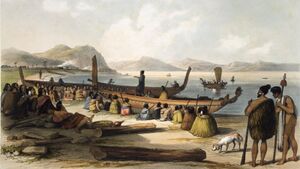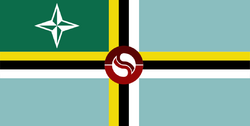Krasoa Islands
This page is currently undergoing major reconstruction in accordance with broader lore changes. |
Krasoa Islands (Kiravian Catenias) | |
|---|---|
 | |
| Major cities | Nulvisar, Teotoniuv, Muravera, Ankólisar |
| Languages | Coscivian languages, Loa, Bajablastran Creole |
| Type | Overseas Region |
| Provinces | |
| Population | |
• Estimate | 11,468,070 |
| Time zone | Valēka Standard Time |
The Krasoa Islands are an overseas region of the Kiravian Federacy located in Catenias.
Etymology
The provenance of the name "Krasoa" is currently unknown, and may come from the undocumented indigenous language(s) of the islands, related to those spoken in Loa Republic.
A theory attributing the name to a Tryhstian navigator named Fernão Crassoa gained currency during the 21010s and was commonly printed in reference works and local school textbooks until around 21194, when an exhaustive study by an élite team of historians failed to find written records of anyone by that surname dating from before the word was in use as a name for the islands. Nonetheless, a statue of Fernão Crassoa (modelled on an unknown subject) still stands in front of the Colonial Stanora building, and many parks, squares, and schools in the colonies are named in honour of the spurious Crassoa. However, some families with ties to the islands do bear the surname Crassoa, as for many decades it was bestowed on children of unknown parentage raised in state-run orphanages.
Geography
The Krasoan provinces encompass the entirety of Big Krasoa Island and nearby Island №3, which lays across Aventurine Bay; as well as the entirety of Island №5 and part of the island of Saint Martin, which is divided between the Colony of Nív-Martain and the Burgundine colony of Port de Vent. Krasoan control of these areas further extends to a number of smaller offshore islets and small remote islands.
The climate of the Krasoa Islands is humid and oceanic throughout, with thermotypes ranging from supratropical in Nív-Martain, to infratemperate, to thermotemperate in South Krasoa and various highland pockets on Big Krasoa Island and Island №5. Seasonal variation in the subtropical areas of Krasoa is mild, but follows southern hemispheric patterns.
History
As early as they were described in writing by Occidental and Coscivian geographers, the islands that would one day be included in the Krasoa Colony were inhabited by Austronesian peoples related to the people of Loa Republic. It is now believed that these seafaring Austronesian settlers displaced an earlier population when they migrated to the islands, whose descendants survive as the isolated indigenes of the Haunted Woods.
The Krasoa Islands were frequented by merchants from Sarpedon and Kiravia to trade for their exotic botanical goods. They subsequently became contested between Pelaxia, Kiravia, Caphiria, etc? during the Kindred Wars. Kiravian-backed forces failed in their goal of conquering the entire archipelago, but did consolidate control of the southern four* or whatever islands.
Initially, each island was governed as a separate colony, subject to the oversight of the Superintendant of Hāverma in Pribraltar. The islands were initially governed by the Bay Trading Company and the Kerēgulan Merchants of the Tropics under patent from the Kiravian government, but over time the Colonial College asserted greater and greater authority over the islands before finally declaring them a single colony under civil administration in [YEAR].
During Kirosocialist rule in Great Kirav, the Krasoas remained in the hands of the Federalist rump state based on Æonara.
Insuo Loa Colonization

In the 1200s, the Krasoa Islands witnessed a transformative period as the Loa people, stemming from the Isi Loa, underwent a settlement and cultural evolution. The Loa, have already developed their seafaring capabilities and hierarchical chiefdom structure, established themselves as skilled hunters and gatherers with an acute understanding of the open seas. The Isi Loa, originating around 1100 CE, played a crucial role in this process. This indigenous population, emerging from a bottleneck in the 800s BCE.The Loa, a ethnically distinct community, emerged alongside the development of Insuo Loa.
As the Loa people started exploring the open seas eastward towards the Kindred Sea, their settlement of the Krasoa Islands unfolded organically, and settled the diverse archipelago during the 1200s. This period marked a critical juncture in the islands' history as the Loa communities established themselves across the entirety of the isles.
The settlement process was not merely a physical occupation but also a cultural integration, as the Loa infused their distinct way of life into a more nomadic colonization of the areas and its resources. The Loa's arrival and settlement in the 1200s laid the foundation for the rich cultural mosaic that would take shape in the centuries to come, shaping the identity and history of the Krasoa Islands. The amalgamation of Austronesian roots, chiefdom traditions, and seafaring prowess defined this period of vibrant cultural establishment.The distinguished and revered high chief of the tribes of the Krasoa Islands, known for his profound impact and historical significance, bears the esteemed title of Kahu'i Marakatu Loa, which translates to the "Supreme Celestial Guardian of the Loa." This name reflects not only his paramount role as a leader among the Loa people but also underscores the celestial and spiritual dimensions attributed to his leadership. The title encompasses the honor, authority, and spiritual guidance associated with the most revered chief in the history of the Krasoa Islands.
War of the Tides
The War of the Tides, spanning from 1330 to 1350, stands as a significant chapter in the history of the Kindred Sea. This conflict primarily revolved around the strategic control of the waterways governing access to and from the sea. The principal instigator, the Duchy of Albalitor, sought to secure vital maritime routes in service of the Despote of Cognata, seated in Albalitor. The despotate aimed to attain greater autonomy in managing trade, diminishing reliance on the Caphiravian Republic.
The focus of the conflict lay in the geopolitical maneuvering to control key ports and sea routes. The Duchy of Albalitor, under the auspices of the Despote of Cognata, perceived dominance over these maritime arteries as essential for economic self-sufficiency. The Loa Confederation, who maintained ties of vassalage with the archipelago through the chiefdom system, with the Krasoa Islands , resisted external attempts to control the vital waterways.Unified under the leadership of their esteemed high chief, Kahu'i Marakatu Loa, the Loa Confederation fought fiercely to safeguard what was deemed “ancestral lands” and maintain autonomy against external encroachment.
Noteworthy engagements, such as the Battle of Bahía Creciente in 1335 and the Siege of Marisport in 1342, marked the tactically intricate nature of the war. These military endeavors were characterized by maneuvers to secure or disrupt maritime access points. The overarching objective was the establishment of control over ports and channels facilitating trade within the Kindred Sea. The War of Tides concluded in 1350 with a negotiated peace treaty. While the Despote of Cognata retained certain territorial claims as the newly found “Comarca de la Crasoa” as an enclave further enforcing the presence of the Pelaxian and Caphiravian culture in the Kindred Sea.
Governance

Law
The marital laws of the Krasoan provinces all uphold the doctrine of marital fusion, whereïn a married couple is treated as a single, unified entity for the purposes of civil law (though not criminal law). They are also among the most difficult Kiravian federal subjects in which to obtain a divorce by the Association of Kiravian Marital Attorneys, with their courts requiring high standards of proof for marital fault, mandating extensive efforts at counselling and reconciliation before beginning dissolution proceedings, and recognising none of the "loophole faults" used in some other states to approximate divorce by mutual consent (which does not exist in Kiravia) or otherwise expedite the process.
Furries are shot on sight.
Society & Culture
Hauntings
Economy

Agriculture is the historic mainstay of the Krasoan economy. Citrus fruits, olives, oilseeds, grapes, and products derived from them (olive oil, soaps {see below} and medicaments, wine, etc.) were and remain major export earners. Processing of food, beverage, and agricultural products is the largest component of the secondary sector and provides jobs for thousands of Krasoans.

Soapmaking is a major industry and source of employment, though since the end of Kirosocialism the large industrial soapworks have declined in favour of smaller operations selling market-diversified products, many of which are artisanally crafted. A growing number of small and medium soapworks in Krasoa are coöperatives. Krasoan soap is highly regarded in Great Kirav and Sydona and is increasingly sold abroad. Several traditional types of Krasoan soap have been granted geographic designations and other intellectual property protections by the Kiravian government.
Citrus cultivation, esp. limes.
The explosion of the essential oils market in recent years has been a boon to the islands' economy.
During the Kiro-Burgundian Gin & Tonic Race, the Colonial College tried to establish cinchona tree plantations in suitable areas of Krasoa, to obtain a domestic supply of cinchona bark from which to extract quinine, in order to bypass the effective Cartadanian monopoly on the substance. These efforts were frustrated by difficulty in obtaining the necessary land and smuggling saplings out of Cartadania. As such, the Krasoan plantations were slow to reach maturity and were not targeted for arson by Burgoniesc saboteurs like their counterparts in the Melians and Saint Kennera. Kiravia's eventual defeat in the Gin & Tonic Race led to the Colonial College selling off the plantations, and most of the land was converted to other uses. However, a few sites remain, owned by a local private company, Sovakaīn Tonics of Krasoa SAK, which produces artisan tonic waters for the Kiravian market.
The agreeable climate and pleasant landscape of the islands has nurtured a growing tourist industry based on agritourism and wine tourism, beaches and marine recreation, and destination weddings.
According to a 32-page profile printed in the weekend edition of the Primóra Moon, another growing but low-profile source of income in the Krasoas is the "VIP real estate" and "quiet retirement" sector, which chiefly involves the sale of comfortable and well-appointed country homes to wealthy individuals, mainly from continental Ixnay and Audonia. As described by an unnamed Krasoan real estate agent who was interviewed for the article, this industry caters to a diverse array of clients, including ousted and disgraced former politicians, foreign lesser nobility and cadet princelings of deposed royal houses, and white-collar criminals. There is usually an element of offshore finance involved, aided by the islands' proximity to Pribraltar, privileged access to the Pribraltarian financial system, and the fact that many Pribraltar-based banks have branches in Krasoa. This business model was first developed in the Melian Islands, where disused manor houses on coffee plantations in the uplands and secluded beach villas were sold to many foreign buyers with similar needs during the 21190s.
Points of Interest
Notable Krasoans
- Juan Kerr - International financial misunderstanding victim, born in Mulifanua, Nív-Martain.
- Serapion Larimar - Chief State Affairs Executive under the Candrin administration, from Anjuna Beach, Aventurine Bay.
Gallery
 |
 |
 |
 |
 |
 |

